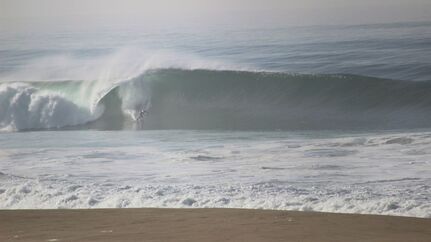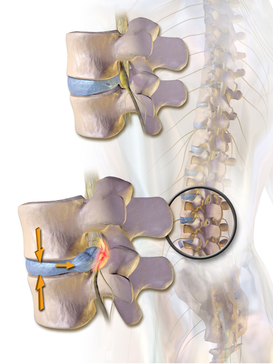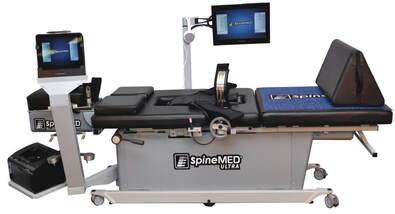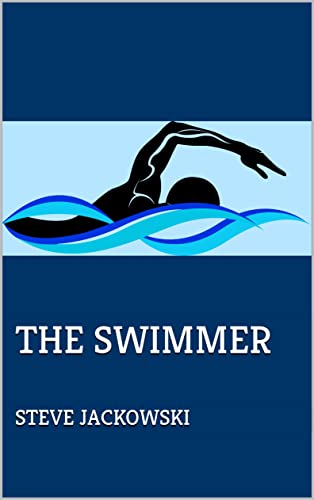 Photo: Derek Cicero
Photo: Derek Cicero It was a beautiful swell from the southern hemisphere and Southern California was seeing double-overhead waves. My friend Tom and I raced to a secret spot north of Los Angeles where we, along with a few others, caught some of the best waves of our young lives. We were both 19. At sunset, Tom went in and I waited for one more. As expected, it was perfection. A nice stand-up barrel after takeoff and then a long workable wall that would take me to the beach.
I knew that my wave would meet an outgoing wave from the steep beach and I expected a huge vertical exit. What I didn't expect was the hyperextension and dramatic compression that would crush two discs (between L5 and S1 and L4 and L5), and would leave me nearly paralyzed on the beach. Tom carried me to the car and it was six months before I could touch my knees and nearly a year before I was back to surfing.
Over the next forty years, I had intermittent back problems some of which would sideline me for weeks at a time. I saw doctors and chiropractors and got temporary relief, but invariably would have flare ups a few times a year. The quality of my surfing was dependent on the condition of my back. When I had no pain, I surfed well. Otherwise, I was slow to get up and conservative in my drives down the line and off the lip.
When there was no surf, I went trail running if my back permitted. At some point, I developed Achilles tendinitis and saw Jeff Moreno at Precision Physical Therapy. He put me through some tests, watched me walk, and declared that like most surfers he worked with, I was an 'Extender'. I had spent most of my life arching my back while paddling, had over-developed back muscles and under-developed core strength. My posture was bad, I sat and stood incorrectly, and I was a mess.
Trusting his judgement, I started developing core strength, corrected my posture, and was diligent in not 'extending'. I later discovered that Kelly Slater had put out a video on core strength for surfing and added those exercises and paddling techniques to those prescribed by Jeff.
Six months later, my back pain was gone. Over the next seven years I had zero back pain. No flare ups. When my fellow surfers complained about back issues, I talked up core strength. I was finally done with back pain and back to surfing at full capacity.
Like most surfers, I've had my share of accidents: a fin into the thigh when a barrel collapsed on me at Wind'n'Sea in San Diego, stitches from run-ins with boards (not always mine) and encounters with rocks and reefs, and a torn MCL, which I rehabbed (see How I Rehabbed my MCL Tear). So, I wasn't surprised when I hit the bottom at the Lane ten weeks ago. Unfortunately, what is normally just a bounce off the bottom was much worse this year because of the portions of the cliff that fell in last winter. Sharp rocks have accumulated in front of the point.
I managed to finish the surf session after recovering for ten minutes, but the next day, I could hardly move. I had hit my sacrum on a rock. There was significant bruising and my back was twisted. After a couple of osteopathic treatments (see another post on Why I Believe in Osteopathy) and a great massage with a 'Q-L Release' from Rochelle at Joy of Movement, I was on the mend. Surfing wasn't a problem and I was dancing, hiking, and playing disc golf.
I knew I was only at maybe 80% recovered but hey, why limit myself? Of course I did something stupid and it was game-over.
 Normal disc and herniated disc with nerve impingement - thanks to Medical Gallery of Blausen Medical 2014
Normal disc and herniated disc with nerve impingement - thanks to Medical Gallery of Blausen Medical 2014 Never having had any kind of surgery, the prospect was terrifying, but I knew I couldn't live in that state.
I met with the surgeon who described the 'minimally invasive' microdiscectomy. It did require general anesthesia. He would make a 3 cm incision, shave the bone and the disc and free the nerve. Aside from recovering from the incision, I should be pain-free immediately after the surgery. Complications were rare. In the meantime, the surgeon prescribed Gabapentin to calm the nerve pain.
Doing the research, it appeared that the only real risk arose if you needed another surgery. The additional scar tissue could complicate subsequent surgeries. The one thing that concerned me was that studies showed that after two years, patients who avoided surgery had the same outcome as those who had the surgery. It looked like aside from the risks of that scarring, the surgery provided a faster way to get pain-free but that alternative treatments could be as effective.
I scheduled the surgery, did all the pre-clearance testing, and two days later - three days before the surgery - I was feeling a bit better. I still couldn't walk or lie down, but I could sit. I was able to get a partial night's sleep - my first in weeks - sitting up. As the surgeon explained, this was the result of the Gabapentin. And that was as good as it got. At least I could sleep a bit.

Hearing about my impending surgery, a friend who had gone through multiple back surgeries contacted me. Several months ago, he was about to undergo yet another surgery (he'd been suffering back pain since a car accident when he was a teenager), when someone suggested he contact Dr. Bernstein at Santa Cruz Osteopathic. After a few weeks of treatments on a spinal decompression machine, he said that he had now gone six months without pain and without medication for the first time in his life (actually, since his accident decades before).
I did the research and discovered that MDs and DOs had a 90-100% success rate with the decompression machine while chiropractors had success rates between 50% and 60%. This was attributed to the DOs and MDs being more experienced doctors who could accurately read an MRI and better target the focus of the machine, as well as the fact that they could better identify patients who wouldn't benefit from the treatment. They also can prescribe medication like the Gabapentin.
I spoke with the surgeon and we agreed to postpone the surgery to see if this would work.
I met with Dr. Richard Bernstein who reviewed my MRI and pointed out my original injury with degradation of my vertebrae from S1 through L4 and the nerve impingement between L3 and L4. He said I was a good candidate for SpineMed treatment. It would give me the spacing necessary to relieve the nerve pain and would stimulate blood flow to the damaged disc and to the previously degraded vertebrae. The treatment wasn't covered by insurance and would require 20-25 sessions. He suggested two 30-minute sessions a day.
Because I still couldn't lie down without major pain, the first sessions were difficult. I had a hard time not moving. I was constantly trying to relieve the pain. I suspect I reduced the efficacy of the machine because I couldn't lie still. By the 10th session, I could lie with legs elevated and minimal adjustments. By the 19th session, I could lie there comfortably, and afterwards, could sit and stand, and walk short distances pain free.
Dr. Bernstein suggested I continue for a few more sessions - one a day for the next week.
Two days later, I was walking well. I also started physical therapy at Precision. I took Precision's Spine Dynamics class, and continued massage with Rochelle. For the first time in over two months, I had zero pain. I tentatively began increasing my walking distance and now, a week after my last treatment on the SpineMed machine, I'm up to 3 miles a day at a rapid pace. Yesterday, I took my new board (which I ordered just before my accident), and paddled for 20 minutes - again with no pain.
My physical therapist is cautioning a slow return to full activity. I have lots of exercises to do, but she thinks I'll be surfing in two weeks. In the meantime, I can stand-up paddle, hike, and start dancing again. I still have some residual hypersensitivity around my knee (about 10% of what it was), but Dr. Bernstein and the physical therapist believe that as the nerve heals, that will disappear.
If you're considering back surgery because of lumbar disc problems, see if you can find a doctor (MD or DO) who has a SpineMed machine. In Santa Cruz, definitely have a talk with Dr. Bernstein.
After doing this treatment and a lot more research, I honestly believe that this is a great alternative to surgery for most lumbar problems and that surgery should really be a last resort.
If you liked this blog, please check out my novels.


 RSS Feed
RSS Feed